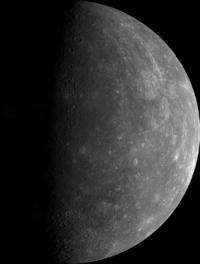December 12, 2011 report
New evidence suggests large asteroid strike may have influenced Mercury's spin

Bob Yirka
news contributor

(Â鶹ÒùÔºOrg.com) -- Planets orbiting a sun generally, but not always spin on their axis. Some spin east to west, others west to east. Those that don’t spin are said to be tidal locked with their sun; always showing it the same face, such as the moon does with planet Earth. In these instances, the planet tends to develop different properties than it would were it spinning. One side is cold, the other hot, for example leading to unique geophysical properties. Also because of the sun’s gravitational pull, more asteroids are likely to hit the far side of the planet, leaving more craters.
It’s partly because of evidence like this that a group of European researchers is proposing that Mercury, the planet closest to the sun in our solar system, was once tidal locked with the sun, but now is not, because, as they assert in their paper published in Nature Geoscience, it was knocked into its current spin by a large asteroid. They even have a likely crater made by the impact to back up their theory.
It’s called Caloris Basin, the largest impact crater on Mercury's surface, and it appears to be just the right size to fit the computer model the team has created. What happened, they suggest, is that long ago, Mercury had an east to west (retrograde) spin, but then over millions of years, slowed till it spun no more. Then, at some later time, the planet was struck by an asteroid large enough to cause it to begin spinning again. But this time, in the opposite direction, though not very fast, causing Mercury’s current 3/2 (three spins on its axis for every two trips around the sun) spin it has today.
The team points out that one side of Mercury clearly has more craters than the other, but perhaps more concretely suggest that the thus far inexplicable hollows inside the Caloris Basin could be the result of ice that was once buried by matter from the asteroid when it hit, then melted as sunlight began to fall on it as a result of the planet spinning again.
And finally, they say, the side that would have been the hot side before being struck by the asteroid would have been flatter than the opposite, more cratered side, do to molten activity. Evidence from Mariner 10 and MESSENGER, suggest that this is the case as well.
It all adds up, the team concludes, to a planet that once spun one way, stopped, then was knocked into spinning the other way.
Written for you by our author —this article is the result of careful human work. We rely on readers like you to keep independent science journalism alive. If this reporting matters to you, please consider a (especially monthly). You'll get an ad-free account as a thank-you.
More information: Mercury's spin–orbit resonance explained by initial retrograde and subsequent synchronous rotation, Nature Geoscience (2011)
Abstract
The planet Mercury rotates three times about its spin axis for every two orbits about the Sun, in a 3/2 spin–orbit resonance. This unique state has been explained by an initial rapid prograde rotation, which was then decelerated by tidal torques to the present resonance. When friction at the core–mantle boundary is accounted for, capture into the 3/2 resonance occurs with a probability of only 26%, whereas the most likely outcome is capture into one of the higher-order resonances7. Here we use a numerical model of Mercury’s rotational evolution to investigate the consequences of an initial retrograde rotation of Mercury. We find that in this case, the planet would be captured into synchronous rotation, with one hemisphere always facing the Sun, with a probability of 68%. Strong lateral variations in the impact cratering rate would have existed, consistent with the observed distribution of large impact basins. Escape from this highly stable resonance can be initiated by the momentum imparted by large, basin-forming impact events, and subsequent capture into the 3/2 resonance is likely. During synchronous rotation, substantial quantities of volatile deposits would have accumulated on the hemisphere facing away from the Sun, potentially explaining the existence of sublimation hollows on Mercury’s surface
Journal information: Nature Geoscience
© 2011 Â鶹ÒùÔºOrg.com




















